What is a 2-way LSD, and why do you need one?
Mechanical LSD and standard LSD by Mazda (Viscous and Torque sensitive) are completely different in mechanism, features and performance.
The mechanical LSD drives the general differential (usually called as open diff) out of tuning market in performance. (stable drive, climbing, cornering, acceleration etc)
For more enjoyable driving we recommend Maruha LSD, which is not only for circuit attack but also drifting and winding roads.
You hear chattering from the LSD. In the case of mechanical LSD, it cannot be avoided.
With low initial setup and additional treatment, Maruha's LSD is designed so that there is not too much chattering.
https://shop.gutentight.racing/products/maruha-2-way-lsd-for-na8-and-nb-miata
2.Open differential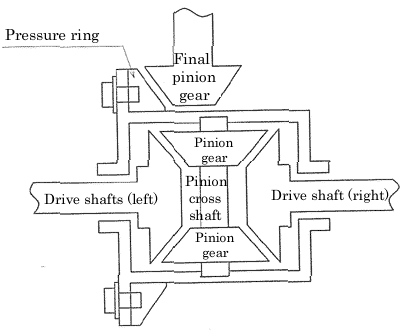
The following parts are for open differential as components.
Side gear (x 2) -------------- to drive shafts (L/R)
Pinion gear (x2)------------ mesh with side gears
Pinion cross shaft (x 1)---axis of rotation for pinion gears
(Going straight)
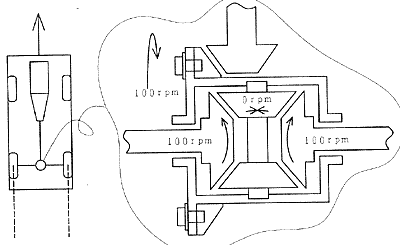
The difference in turning speed between left and right drive shafts does not happen, and left and right side gear rotate together.
So pinion gears do not rotate.
Example :
Input rotation to the differential (Finial pinion gear) 100rpm
Left drive shaft : 100rpm
Right drive shaft : 100rpm
(Cornering)
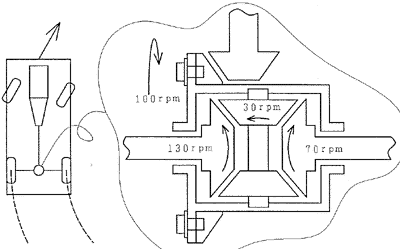
The case of turning to the right
The right drive shaft is inside (slow rotation), the left drive shaft is outside (fast rotation).
Cornering is smooth.
The right side gear rotates slower than the differential case.
The pinion gears rotate, and give the rotation speed of the spinning opposite way to the left side gear.
The left side gear rotates faster than the diff case.
Slow rotation of the right drive shaft and fast rotation of the left.
This balance is transmitted through a differential.
The difference of rotation speed between right and left drive shafts is adjusted to keep the balance automatically based on the large load wheel.
Example :
Input rotation to the differential (Finial pinion gear) 100rpm
Left drive shaft : 70rpm
Right drive shaft : 130rpm
Demerits of an open differential
Can not escape from a muddy place.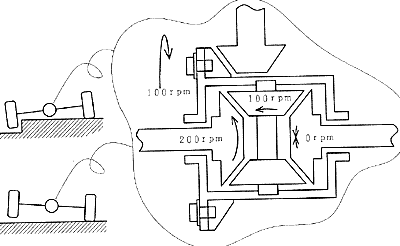
When the one wheel to drive slips in a muddy place, the load of that wheel is zero(0), the opposite side wheel receives all traction.
The grounded wheel does not rotate.
The slipping wheel rotates with two times more speed.
After all, the vehicle can not move at all.
It is impossible to transmit traction during hard cornering.
The inside wheel is rifted in hard cornering by centrifugal force.
In this case, the inside wheel loses the traction at the moment and the speed lessens.
Under usual driving conditions on streets, the torque of the drive shafts changes constantly being affected by road situation and the tires keep the balance through the differential.
LSD is the device to get the high driving force as much as you can.
3.Maruha mechanical LSD
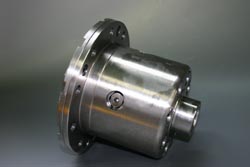
This kit consists of 25 parts.
Side gear (x 2)・・・Connecting to drive shafts (L/R)
Pinion gear(x4)・・・Coupling to side gears
Pressure ring (x2)・・・kept in a differential case, and can slide by cam mechanism.
Pinion cross shaft (x1) ・・・axis of rotation for pinion gears
Clutch plates (drive x4)・・・friction plates rotating with a diff case
Clutch plates (driven x4)・・ friction plates rotating with side gears
Spring plate(x2) ・・・pushing clutch plates at all times
Washer(x2) ・・・ receiving trust from side gears and prevent from blowout
Pinion gear rotates based on pinion cross shaft, side gears mesh to pinion gears.
Pressure rings can slide and have a ditch like the letter V to set the pinion cross shaft.
The pinion cross shaft floats between the pressure ring (left and right) and doesn't connect to the differential case.
The pinion cross shaft is installed directly to the diff case on open differential.
Each clutch plate (drive and driven) is set mutually between a pressure ring and a differential case.
(LSD motive power)
When the accelerator is on the motive, power is input to the LSD and the pressure rings and the differential case start rotating together.The drive shafts keep the speed by inertia.
These both powers (accelerator on / drive shafts) bump at V ditch between pressure rings and pinion cross shaft.
Thus the gap comes out between the pressure rings and pinion cross shaft (V ditch), the pinion cross shaft pushes the pressure rings to open, and the clutch discs are locked firmly by sliding of the pressure rings.
Side gears of the left and right connect to the clutch plates. The lock ratio of the side gears is changeable by V ditch movement as " cam function".
This cam function is by traction (acceleration on/off) and inertia (drive shafts rotation) to keep the balance.
Therefore it is called " torque response type" .
The mechanical LSD is not 100% lock type.
We can change the feature of the cam function.
l In the case of a wider angle of V ditch.
The force of the Pressure ring opening is stronger. The LSD effect is firm.
l In the case of more narrow angle of V ditch.
The force of the pressure ring opening is weaker. The LSD effect is infirm.
There are three types of cam functions of the V ditch.
1 V ditch with left and right symmetry----" 2way type "
The LSD is effective in both cases - when the accelerator is ON/ OFF
2 V ditch with left and right is not symmetric----" 1.5way type"
The LSD effect is infirm when the accelerator is OFF.
3 The V ditch with vertical angle on one side-----" 1 way type "
LSD effect is zero when the accelerator is OFF.
(Initial torque)

The spring plate(x2) puts pressure on the clutch plates all the time.
The friction of clutch plates by this pressure is the " Initial torque".
The initial torque has two roles.
- Controlling cam function at some degree → Preventing hunting by a little bit of torque changing.
- Assisting cam function when the wheel slips→Improvement in pick up.
If the initial torque is set harder, the LSD becomes effective all the time (Not torque response type),
and it causes lower performance at cornering.
To adjust these conflict roles, you should consider your usage first and then decide a spec.
Example :
Race, circuit, drifting ------High initial torque →The priority of LSD effectiveness.
Street-------Low initial torque→The priority of torque response
It is said that the 1 WAY or 1.5WAY LSD is meant for beginners and the 2WAY LSD for advanced users and drifts.
Is it right?
Users who think about setting up mechanical LSD, might find information in magazines etc. and might be wondering which LSD to choose.
Here we would like to introduce Maruha’s LSD.
-
Is 1WAY LSD meant for beginners?
As we’ve already mentioned before, there are 3 types of mechanical LSDs: 1WAY, 1.5WAY, 2WAY. Out of these 3 types the 1WAY LSD ‘s corner approach is very good and that’s why it is being referred to as the one for beginners. However, this might lead to some misunderstandings. In the case of 1 WAY the LSD works only when the accelerator is ON. It is said that at the time of braking, before cornering (accelerator is OFF), the LSD’s work is not necessary. We would like to emphasize that this is only valid for FF vehicles and not for FR vehicles like Miata/MX-5.
- Which LSD is good for corner approach?
- The picture below shows corner approach

Blue line: approach of 1WAY LSD FF vehicle
Green line: approach of 2WAY LSD FR vehicleWe would like you to understand the differences between FF vehicles and FR vehicles.
The basic operation when entering a corner:
a. braking
b. cornering
c. clip point
d. throttle opening
e. Brake-outOut of these operations in between b and c the throttle is off or at half.
Especially in the case of b even if the throttle is off the LSD works but the understeer occurs. However, this can mainly happen in FF cars.
-
The difference between FF cars and FR cars
The Miata/MX-5 is an FR car. During steering its nose turns inside. During cornering the operating rear’s LSD effect doesn’t lead to difficult turning. The 2WAY LSD’s benefit is good position control by the throttle work.
-
1.5WAY LSD
The LSD between 2WAY and 1WAY is called 1.5WAY LSD.
The 1.5WAY is a type of the 2WAY LSD. If it is effective only when the throttle is ON then it is 1WAY. If it is effective even during ON and OFF, then it is 2WAY.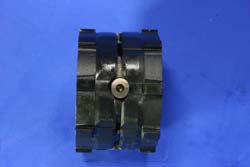
The LSD changes depend on the initial torque, disc type, disc amount and the pressure ring’s cam angle.
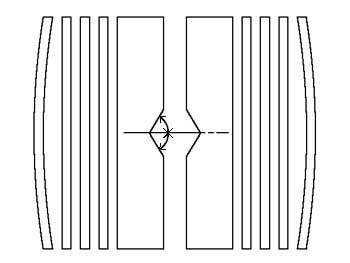
The illustration shows the 2WAY LSD.
To which types of cars does the 1.5WAY fit? FF or FR? Basically, it fits FF cars the best.
In the case of TRD and NISMO LSD 2WAY is recommended for FR cars and 1.5WAY is recommended for FF cars.
-
Big disc rotor, high disc number
In the points through 1 to 4 we analyzed the LSD types (WAY) but we have to pay attention to the disc amount and diameter too.
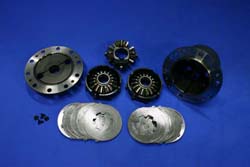
「The LSD’s lock is not 100%.」
Depending on the throttle’s ON/OFF state, the pinion gear shaft presses the pressure ring from the inside towards the outside. The pressure adjustment happens by the pressure ring’s angle. The extending pressure crimps the discs and locks the LSD. It becomes locked by the crimp force but there is also a loss. This loss might be the too high tire grip or the big difference in the inner and outer wheels or the small cam angle.
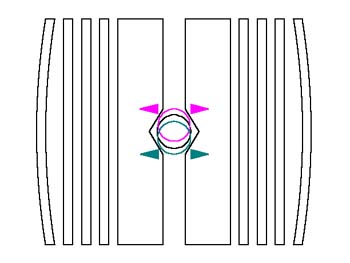
The locus of the pinion axis.
Throttle ON: green Throttle OFF: red
2WAY LSD
The loss means that it has not been locked for 100% but it doesn’t mean that it is bad.
By lowering the initial we aim for easy drive and lock.
Compared to the usual mechanical LSDs Maruha’s LSD’s diameter is bigger and has more feathers.
-
The reason for the trouble is also in the material of the case
The reason for the maker’s LSD trouble lies in the case’s damage. Especially when you use it under hard conditions the pressure inside the case grows and it breaks.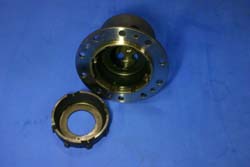
To avoid this kind of trouble the casing’s material has to be stabilized. The maker’s LSD is made by casting. Maruha’s LSD is made of carbon steel. Furthermore, the case’s diameter is optimal.
-
About the initial torque
How many kg should the initial torque be? The initial torque is the pressure inside the case that makes the disc crimp. In the case of discs with multiple feathers crimping happens through the coned disc spring. By this pressure the discs slip. Maruha’s initial is 7kg (±1kg). By changing the initial it is possible to change the time until the LSD lock. Depending on the cam’s function the pressure ring that is spreading to the outside press-fits the disc and the LSD locks. For this reason it takes some time until the pressure becomes low. In other words, the higher the initial the faster the LSD locks (it responds faster to the acceleration) and the lower the initial the duller the lock.
-
The disc’s pressure fitting at the cone spring and the coil spring
To produce the initial torque we use the springs. Usually the coned disc spring is being used but there are also cases when the coil spring is used.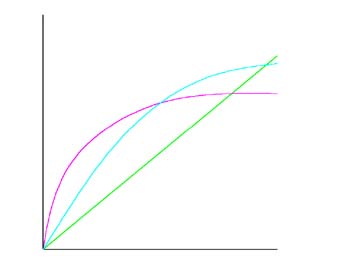
Vertical axis: spring force
Horizontal axis: swagGreen: coil spring
Red: universal cone spring
Blue: Maruha LSDThe spring force of the coned disc spring used in Maruha’s LSD almost doesn’t change.
With this characteristic even if the plate’s thickness changes a little, the initial torque won’t change.
The cone spring’s performance is different from that of the coil spring. It can maintain the same spring force from one specific area and it provides long stable efficiency.
-
Why does the efficiency change because of the oil?
The differential’s oil’s main function is to lubricate the gear. In the case of a mechanical LSD it is important to choose the oil keeping in mind not only the gear’s lubrication but also the LSD disc’s wear prevention. If the viscosity of the oil that enters between the discs is high, it can keep the disc from slipping. This happens because of the oil’s shear force.
-
The effect of the additive (LM-1201)
Depending on the oil the LSD’s characteristics change. In other words, chattering doesn’t occur easily. With Maruha’s LSD we use the LM-1201 additive. It works well with the oil. It penetrates the disc and controls chattering.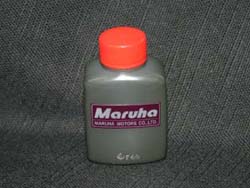
-
How is the disc’s abrasion
Many people think that a disc that’s been used for a long time is abraded and becoming thinner. However, we checked it with our micro meter and found that the disc is almost in the same condition as the new one. There is no recommended timing for the O/H of the LSD. The LSD’s abrasion differs a lot depending on the usage. Maruha’s LSD uses 12 big discs. This lengthens its life and allows it to keep its efficiency. It is highly efficient with a reasonable price.
Feel free to contact us for further information.

